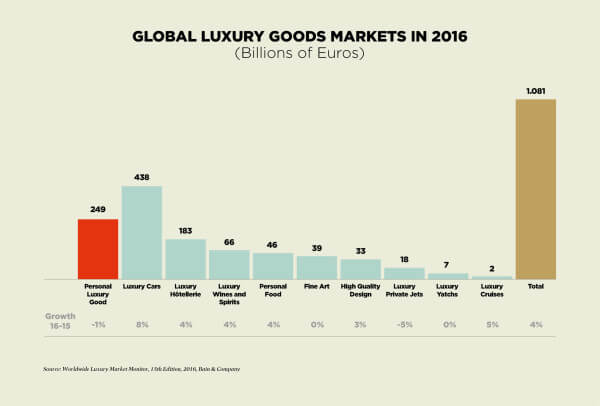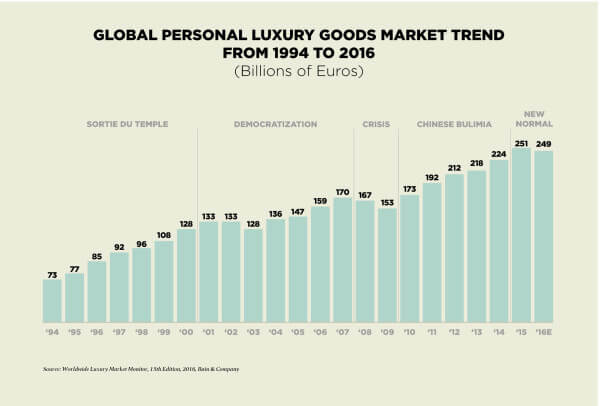In the eye of the consumer, some luxury companies are more equal than others, or so it would seem in the light of the latest Bain & Co Worldwide Luxury Market Monitor, the fifteenth in the series, for 2016. While the market will continue to grow this year, the forecast rise of 4% to €1.081 billion is hardly cause for celebration. “After strong growth driven by Chinese consumption between 2010 and 2014, we have entered a less flattering new normal with more moderate growth rates,” commented Joëlle de Montgolfier, senior director at Bain & Co, in Le Monde. As the study reveals, only the luxury cars segment has turned up trumps; it is expected to end the year 8% higher at €438 billion. In contrast, the second biggest category in sales terms, personal luxury goods (apparel, leather accessories, jewellery, watches, fragrance and cosmetics), is heading for a harder landing and is forecast to end the year 1% down at €249 billion.

Experience luxury
The reasons behind these difficulties, already widely commented upon, range from unfavourable exchange rates – and this applies to both the euro and the Swiss franc – to insecurity which has deterred tourists from visiting Europe, political volatility in the pre-election United States, the underlying threat of Brexit, and a downscaling of Chinese spending overseas. This is, in fact, the first time Chinese spending on personal luxury goods has fallen, dropping from a 31% share of the global market to 30% between 2015 and 2016. In a market that has virtually doubled in fifteen years, from €128 billion in 2000 to this year’s estimated €249 billion, this sudden flatlining is also a consequence of new purchase patterns among luxury consumers. According to the Bain & Co report, spending is directed more towards experiences than goods, as consumers seek enjoyment over ownership, a fact borne out by statistics. Cars aside, the top-performing luxury segments this year will be hotels, wines and spirits, fine dining and cruises.
The watch segment, which is currently struggling with overstocking, is needless to say hard-hit by these trends.
The third market is online
Another factor shaping the market has been the meteoric rise of digital shopping. With a compound annual growth rate of 26% between 2013 and 2016, e-commerce is by far the top-performing distribution channel, ahead of outlet (+23%) and airports (+13%). The explosion in online sales has been so great that Bain & Co is calling this the “third market”, after the United States and Japan; a market now worth €19 billion or 7% of the personal luxury goods segment, a third of which comes from brands’ e-commerce sites. “Two years ago, out of a panel of 270 luxury brands, 40% didn’t have an online store,” notes Joëlle de Montgolfier. The watch segment, which is currently struggling with overstocking, is needless to say hard-hit by these trends.

Indeed, watch brands will suffer most this year, with sales forecast to contract by 8% to €36 billion. Jewellery, in contrast, is expected to fare reasonably well (+2%), as are cosmetics (+4%) and accessories (+1%). Overall prospects for personal luxury goods are gloomy, with Bain & Co forecasting compound annual growth of between 3% and 4% for 2017 to 2020. The winners will be those who succeed in catching the eye of jaded consumers with innovative products, and those who are able to profit from the widening base of the luxury pyramid with genuinely competitive entry-level offerings.













